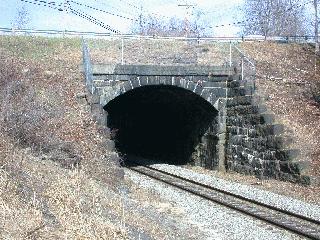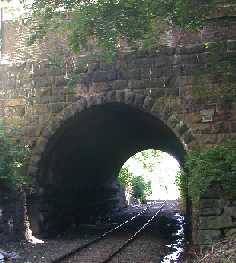

 |
 | |
| Westerly portal of Dover, NH arch on the B&M. | Northerly portal of Greenfield, MA arch on the B&M. |
When New England's earliest railroads were built starting in the late 1830s, the best available technology for bridges with spans of up to 50 or 60 feet was the stone arch. Good granite was plentiful, and where the investment was warranted, a stone arch could be expected to support heavy loads with little maintenance. Well-financed lines used stone wherever practical, and even a route built on a shoestring might use stone in a few locations, to project an image of prosperity. This practice continued until iron and steel bridge technology matured in the 1870s and 1880s.
Quite a few of these stone arch bridges survive, ranging from the various sizes of granite culverts found on many active and abandoned lines, to big arch bridges and viaducts like the Concord River bridge at Lowell, MA and the Canton Viaduct on Amtrak's electrified Northeast Corridor main line between Boston and Providence. Some, like the Western Railroad's dry stone arches over the upper Westfield River between Springfield and Pittsfield, MA, have attracted the interest of historians and preservationists.
One major difference between early New England railroads and those built later, or elsewhere in the country, was that the alignment often passed near or through the center of an established town. If the desired railroad grade required cutting below street level, the streets were sometimes carried over the tracks on "cut and cover" stone arch tunnels. Where only one street needed to pass over, the arch would be less than 100' long, depending on the width of the road and the difference in elevation. Where real estate values were high, an early appreciation of "air rights" led to tunnels several hundred feet long, often topped by buildings.
In later years, several of these structures came to be known as "arches" by railroaders, as in the "Dover Arch" or the "Greenfield Arch". Although I've heard the Walpole, Massachusetts structure called the "kissing bridge", I use the term "arch" to refer to them all. Here is a list of original "arches" I know of, with the railroad that built them and current status:
| Location | Building RR | As built | Date | Status |
|---|---|---|---|---|
| Bellows Falls, VT | Vermont Valley | 275 ft., single track, under commercial buildings | 1851 | Drastically deepened in recent years, in use by New England Central, Amtrak Vermonter, Pan Am Ry. |
| Dover, NH | Boston & Maine RR | 100 ft., single track, crossed by a residential street | 1840s | Rebuilt 1907 to double track, single tracked 1958, in use by Pan Am Ry. and Amtrak Downeaster service |
| Greenfield, MA | Connecticut River RR | 100 ft., double track, through the business district | circa 1848 | Single tracked circa 1960, in use by Amtrak's Vermonter and freights of New England Central and Pan Am Ry. |
| Hartford, CT | New York, New Haven & Hartford RR. | Two double track arches under Albany Ave. | 1871 | Replaced a grade crossing, in use by Amtrak/CSX |
| Lowell, MA | Boston & Lowell RR. | Single track under Middlesex Street | circa 1835 | Replaced by an overpass before 1900 |
| Newburyport, MA | Eastern RR. | 70 ft., gantlet track after 1880, crossed by a residential street | 1838 | Replaced by current High St. overpass circa 1920 |
| Salem, MA | Eastern RR | 700 ft., single track, under a main downtown street | 1838 | Replaced by current Salem Tunnel in 1958 |
| Walpole, MA | Boston, Hartford & Erie | 100 ft., under Rt. 1A | 1860s? | Single tracked, in use by MBTA commuter rail, CSX. Track plan and photos in Model Railroader Sept. 1967 |
As a New England modeler, I find the arches interesting in several ways. They remind the audience of the earliest era of American railroading, and help provide an appropriate scenic context for my models. They can be used to separate scenes in contexts where a more conventional tunnel would be out of character. And in cases like Salem and Newburyport, where a single track arch (using gantlet track in Newburyport's case) separated the passenger station from the engine terminal and coach yard, they provide an interesting operating focus.
Although the arches were built with what were probably felt to be generous dimensions at the time, they presented problems when engines and cars got larger in later years. The Salem Tunnel was too tight for most of the steam locomotives the B&M purchased after 1920, which cemented the dominance of the original B&M route through Exeter, NH as the through freight route to Maine. New steel boxcars built with a 10' 6" inside height (after the PRR forced their X-31 class on the rest of the North American railroads in 1931) were also too large - from the 1930s until 1958, the High Car job ran daily from Boston to the Northey Point yard via Wakefield Junction and Peabody.
When the B&M wanted to start Trailer On Flat Car service in the mid-1950s, the arches at Greenfield and Dover were too small. This was solved by reducing their double track to single, and installing CTC. They've all been through several cycles of being dug out deeper since then, but even so none allow double-stacks.
The arch at Bellows Falls remained an obstacle into the 1970s. The buildings above it prevented it's being daylighted. The bridge over the power canal north of the tunnel had too little clearance above the water to be lowered. This bottleneck kept first the Cheshire Branch through Keene and then the old Northern Railroad route from White River Jct. to Concord and Boston active as alternate routes for over-dimension cars. It wasn't until Vinay Mudholkar, later Chief Engineer of the B&M, figured out how to reduce the depth of the bridge decking that the arch could accomodate TOFC traffic.
After the Connecticut River line was taken over by the New England Central in 1989, further excavation has lowered the bottom of the tunnel enough to accomondate double-stacks. This produced a toy-train-like elevation profile in the southern approach.
Maintained by James B. VanBokkelen .